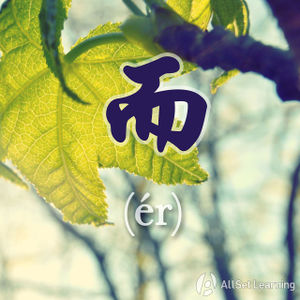Difference between revisions of "Using "er" to explain contrasting ideas"
| Line 8: | Line 8: | ||
Sentence 1, + 而 + Sentence 2 | Sentence 1, + 而 + Sentence 2 | ||
| + | |||
| + | </div> | ||
| + | |||
| + | As you can see, 而 comes between the two to heighten the contrast. | ||
| + | |||
| + | Frequently you'll see the pattern in one of these two more specific forms: | ||
| + | |||
| + | <div class="jiegou"> | ||
| + | |||
| + | 不是……,而是…… | ||
| + | |||
| + | </div> | ||
| + | |||
| + | <div class="jiegou"> | ||
| + | |||
| + | 是……,而不是…… | ||
</div> | </div> | ||
Revision as of 06:31, 14 September 2018
-
Level
-
Similar to
-
Used for
-
Keywords
The conjunction 而 (ér) is used to connect two sentences that are related to each other, but talk about contrasting ideas or subjects. In this manner, it can be seen as a word meaning "but" or "rather." 而 is often used in a more formal or literary sense, but it is also common in everyday speech.
Structure
Sentence 1, + 而 + Sentence 2
As you can see, 而 comes between the two to heighten the contrast.
Frequently you'll see the pattern in one of these two more specific forms:
不是……,而是……
是……,而不是……
Examples
- 我们 都 以为 这 是 他 干 的,而 事实 是,他 根本 不 知道 这 件 事情。We all thought this was his task, but the fact is, he simply doesn't know about this topic.
- 以后 后悔 的 人 不 是 我,而 是 你 自己。The regretful person isn't me. It's you.
- 现在 要 做 的 不 是 责怪 谁 错 了,而 是 怎么 解决。Now is not the time to accuse who did it wrong, but to figure out how to resolve it.
- 我 喜欢 中国 菜,而 他 不 喜欢。I like Chinese food, but he does not.
See Also
Sources and Further Reading
Books
- Integrated Chinese: Level 2, Part 1 (pp. 343-4) Anything Goes (无所不谈) →buy
- 卓越汉语-公司实战篇 (pp. 128, 200) 卓越汉语-公司实战篇 →buy
Websites
- Yale Chinese Usage Dictionary: Usage of 而



